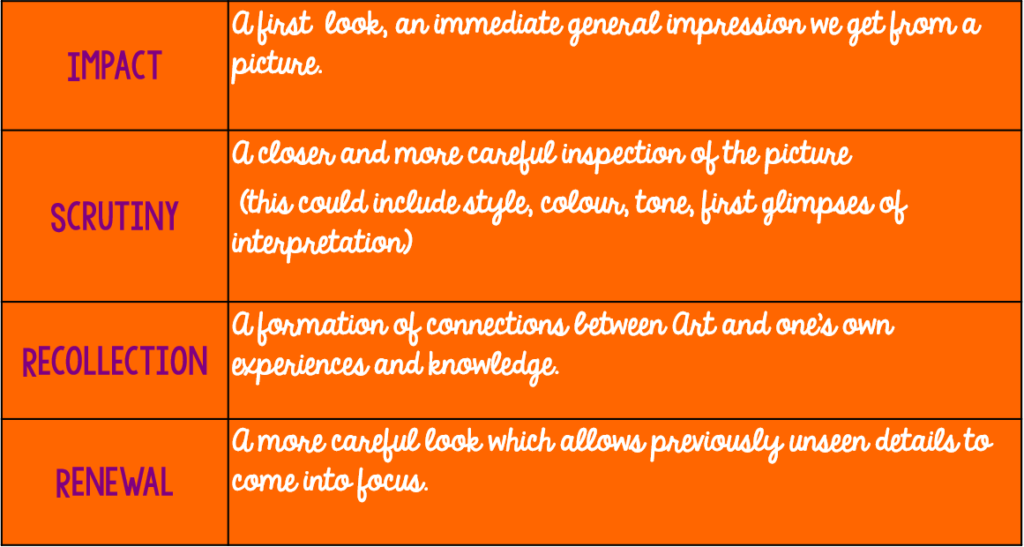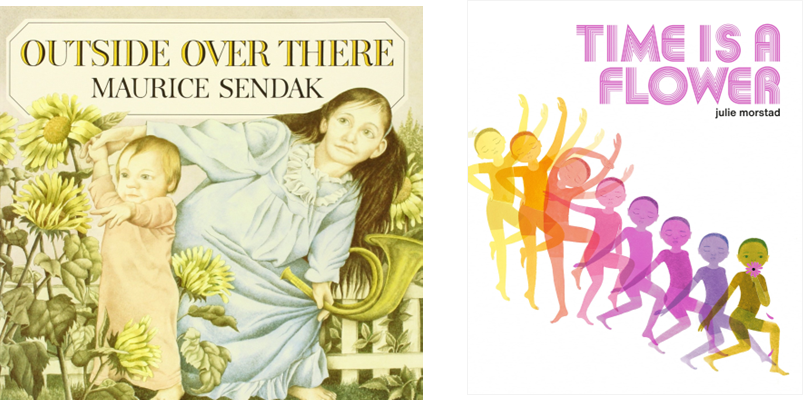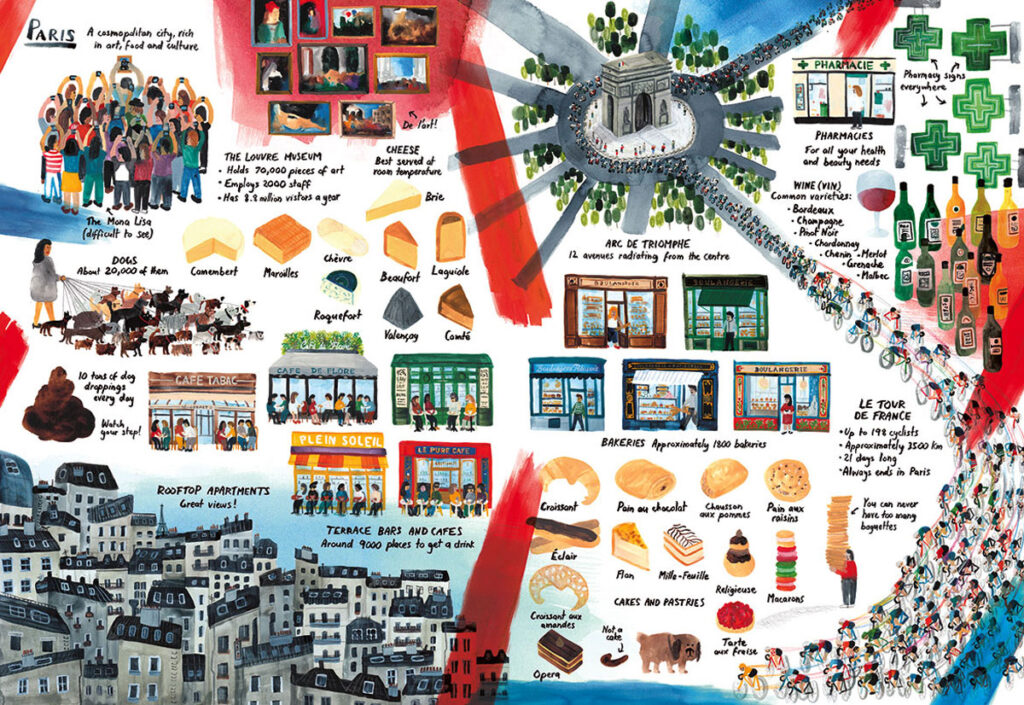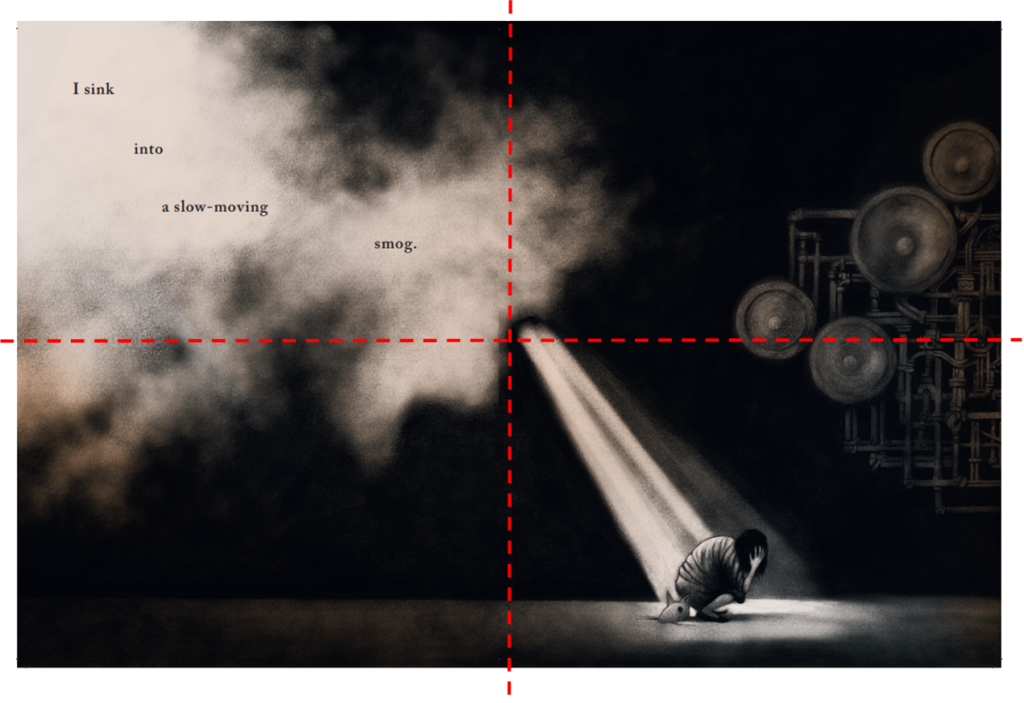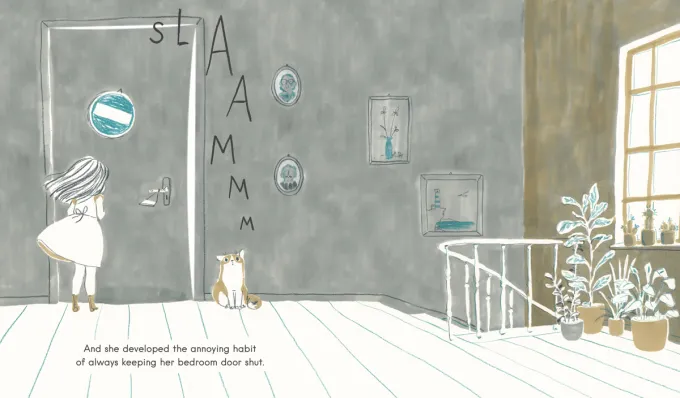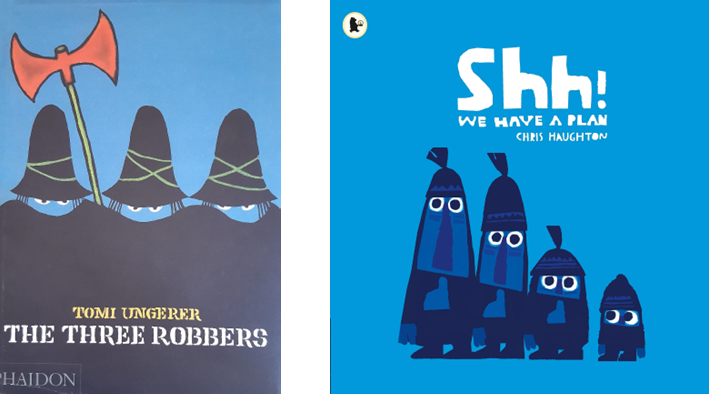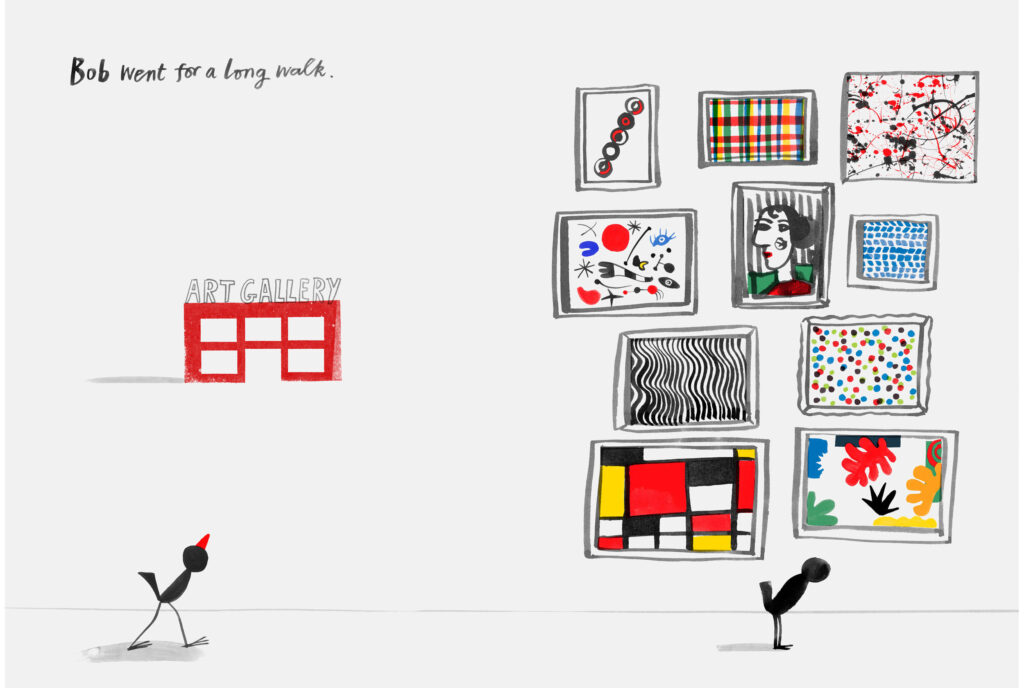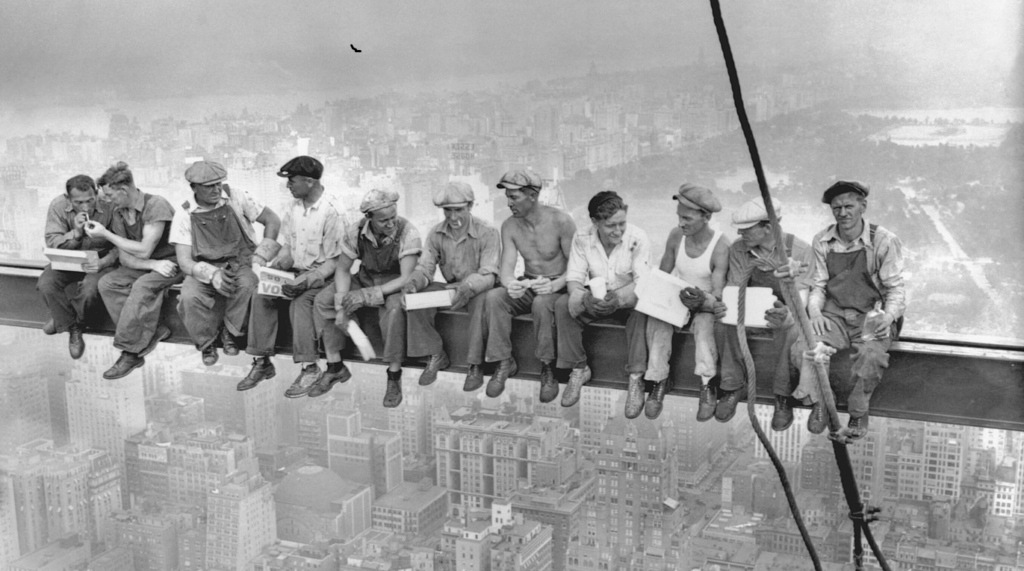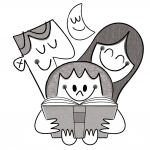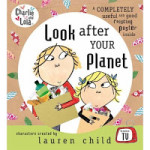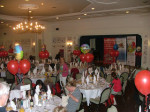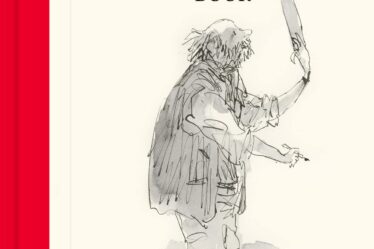I have been revisiting my dissertation (a very painful experience I may add as I hate reading my own work) to reacquaint myself with picturebook theory. Part of it included researching , via the excellent Children Reading Pictures: Interpreting Visual Texts by Evelyn Arizpe and Morag Styles, and applying art theory by art historian Kenneth Clark. In his work Looking at Pictures, Clark gathers essays that were originally published in The Sunday Times, and each focuses on a famous piece of artwork, from Velasquez to Seurat via Courbet and da Vinci. Though the essays are enjoyable in themselves, the interesting part of this book can be found in its introduction where Clark writes about his process when approaching Art.
This process is made of in four phases: impact, scrutiny, recollection and renewal:
Clark’s framework focuses on individual pieces of art, but there is no reason why it cannot be applied to whole narratives. In my dissertation I looked at how this approach can be applied to children’s response to picturebooks but I am also interested in how this approach works in terms of adult readers, as co-readers but also as picturebook enthusiasts.

The reader comes across the picture(s) and gets a first general impression and reaction.
Even when seeing an image fleetingly, for example if there is a quick turn of the page, we experience this first stage. As Clark says, “Long before I can recognise the subject I am conscious of a general impression, which depends on the relationship of tone, and area, shape and colour” (16).
According to research, the brain processes images before text, and readers look at the artwork before they turn to the words (for pre-literate readers, the artwork is the only entry point into the story unless assisted by a co-reader). The first read of a picturebook therefore mirrors the impact stage, and the very first impact will be created by the book cover (you can read more about book covers here) and other peritext; they help transmit the mood and themes of the story and are therefore crucial to the impact stage.
Response at this stage will differ for adult readers because even a fleeting response will have been influenced by our experiences of the world. As a result, I think adults have a stronger “I like it/I don’t like it” initial response to Art. This response is not about appreciation of Art, and what the Art might convey, but a gut reaction. The two covers below initiate two very different gut reactions from me, for example:
A negative first reaction does not necessarily mean there is no impact, however. As long as there is engagement with the picture, there is an impact. In terms of looking critically at picturebooks, I think this first phase is crucial and needs to be embraced by adult readers; only once we have acknowledged our initial feelings can we proceed to looking with a more pragmatic and objective eye, which leads us to the scrutiny phase. One way of doing this could be to write initial thoughts down. That’s how I start with students when doing mock judging of picturebooks.

The reader looks more carefully at the picture(s)
For the child reader, looking more closely at the artwork might be facilitated by a co-reader during joint-attention reading, for example if the adult is pointing at specific elements, but it might also take place while looking at pictures alone. A book like Lots by Marc Martin, with so many details on each double-spread is perfect for practicing careful looking.
For adult readers, this scrutiny stage is the beginning of a more analytical read of the artwork. With a more careful look, motifs such as line, colour, shape, space begin to emerge and thus interpretation begins. There are many frameworks that allow us to look at picturebooks analytically: Moebius’ Introduction to Picturebook Codes (some of these are applied in a review I wrote about Town is by the Sea), Picture This by Molly Bang, and Reading Picture Books with Children by Megan Dowd Lambert to name a few. Every one will have a slightly different approach, or a mix of several approaches! A couple of years ago, I wrote this to support looking at visual elements for the 2021 Greenaway Medal, using examples such as the spread from I Go Quiet by David Ouimet, and this gives a few pointers as to what to look for when in the scrutiny phase.

The reader begins to make connections with previous experiences.
Clark’s third phase, recollection, allows viewers to connect the picture to their own experience and knowledge. The brain begins to merge new knowledge with what readers already know. As Arizpe and Styles suggest readers link what is happening on the page with their own personal experiences and memories, converging in a “text-to-life moment” (44) .
This may take several forms for a child reader, such as recognising a behaviour or an emotion previously experienced, for example when reading Whatever Happened to My Sister? by Simona Ciraolo. Here the muted palette mirror the feeling of sadness and being left out, as if the sister by shutting out her younger sibling, has taken all the fun and colour out of her life. Scrutiny and recollection work hand in hand here.
Children who are regularly exposed to picturebooks may also be able to recognise illustrators (“those drawings are similar to the ones in …”) or make connections between books that have a similar style:
For adults, the recollection phase will be very different. A few years ago I wrote about Mo Willems’ Nanette’s Baguette and this is a good example of how recollection might work on a slightly different level for the adult reader. In this case, the recollection phase relates to the nostalgia of childhood.

Adults having acquired a vaster cultural capital will also be able to observe interpictorial references and references to other cultural markers in a way that young readers will be unable to. This is also part of the recollection phase. These might just be reproductions of works of Art such as in Dick Bruna’s Miffy at the Gallery, Ruth Brown’s A Gallery of Cats, or as below Marion Deuchars’ Bob the Artist. In these books, characters are visiting art galleries, and in this case the interpictoriality is completely overt.
Anthony Browne is renowned for his interpictorial work and his allusions, both overt and covert, to surrealism and Magritte in particular. Silly Billy has many examples of this, using dream sequences as the perfect platform (the book also includes a splendid reproduction of “Wanderer above the Sea of Fog” by Caspar David Friedrich)
This double spread below is from Morris and the Magic of Stories by Didier Lévy and Lorenzo Sangió is a cornucopia of interpictioral markers, some the children will know (Little Red Riding Hood, The Little Mermaid, Puss in Boots), some maybe only French children will know (The Little Prince) and some only the adult readers will know (The Ring, 2001: a Space Odyssey, One Punch Man). The artwork is overtly talking to two different audiences, encouraging the recollection phase for different readers.
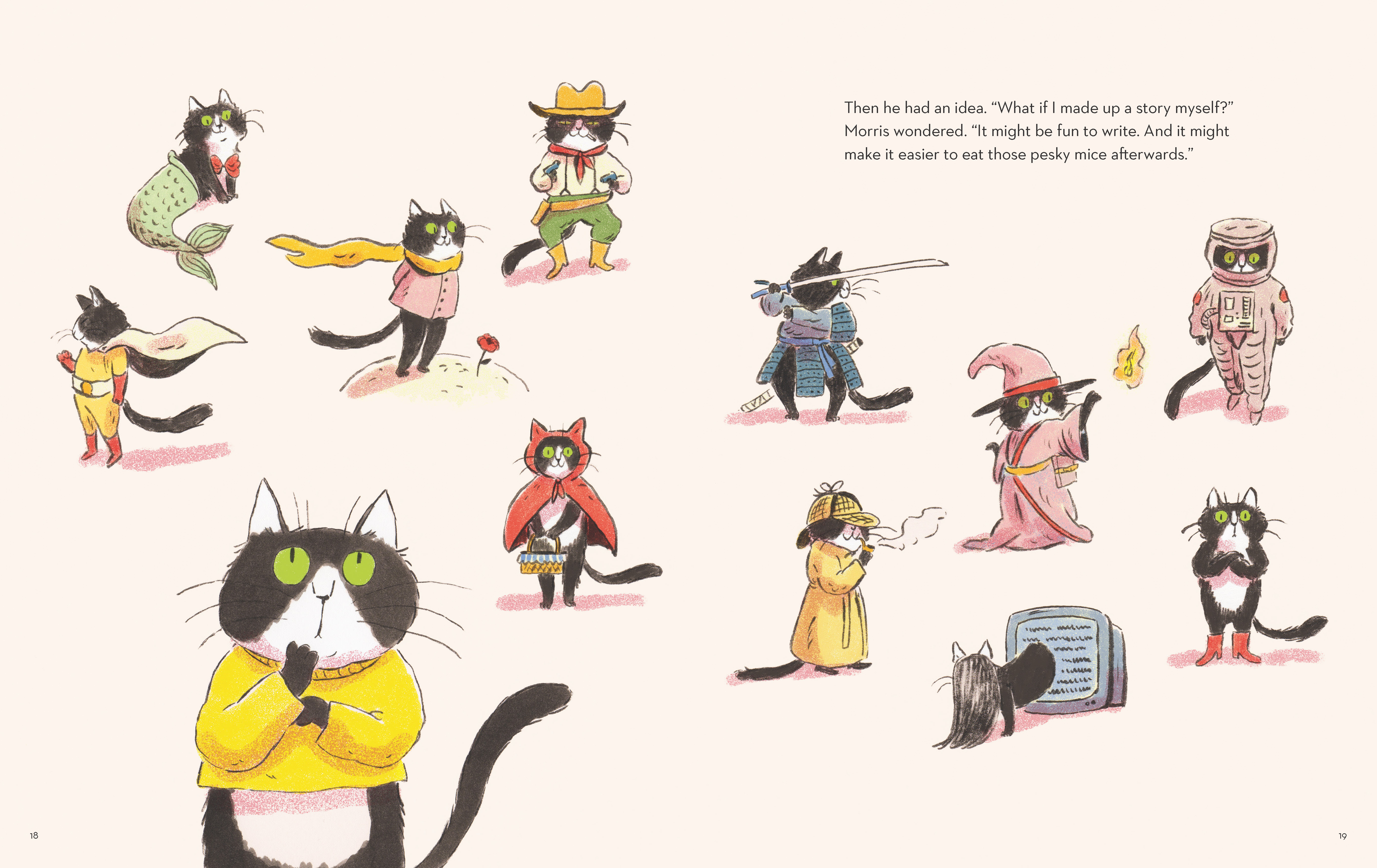
What happens at the at the recollection phase is unique to each reader, depending on their knowledge and cultural background. I studied American History quite a bit at university, particularly the New Deal so when I saw the below double-spread in Erika Meza’s To The Other Side (a story of children refugees trying to cross a border to safety):
I made an immediate connection to this:
This is “Lunch atop a Skyscraper”, a famous promotion shot (photographer unknown) from the construction site of the Rockefeller Centre taken in 1932, which has long become a symbol of American prosperity and the American dream. Would have I made this connection so instantly if I had not studied that part of History at university? I can’t be sure of course, but it is a possibility that image was embedded deep in my subconscious because of my course.

The reader looks again carefully, allowing previously unseen details to come into focus.
This final stage is intrinsically linked to rereading, which allows to take in more details previously undetected. As the text read by the adult co-reader becomes familiar, children may tune in to the artwork more; they are no longer searching for “meaning” in terms of supporting the story, but might be looking for those little details that might have escaped them. It allows more immersion in the artwork , but in this re-reading is also a process of scaffolding of understanding, which happens over time. As children acquire more experience in their everyday life, they are able to bring new and deeper meaning to the stories, “renewing” their response to the art by making new inferences. For the child reader, scrutiny, recollection and renewal happen in a continuum.
The experience of this stage will be widely different for an adult reader; while renewal is intrinsically linked to rereading for an adult too, this stage is much more likely to be about slowing down the reading and allowing us to take in those little details and connections that we might not have noticed in the haste of the first read (I am 100% guilty of this). While the scrutiny stage gives us our first glimpses of meaning through Art, the renewal stage deepens our understanding. Slow, careful re-reading is pivotal to looking at picturebook narratives critically. This is particularly true of wordless narratives; how can a reader take in everything in a single reading when looking at The Tree and The River by Aaron Becker? Even the most thorough readings in the scrutiny phase would not give you enough insight.

While Clark’s framework is not fool proof when looking at picturebooks, I think it provides an easily workable process to follow, or at least to bear in mind, when looking at picturebooks critically.
References
Research
Evelyn Arizpe & Morag Styles. Children Reading Pictures: Interpreting Visual Texts (RoutledgeFarmer, 2003)
Molly Bang. Picture This: How Pictures Work. (Chronicle Books, 2016)
Kenneth Clark. Looking at Pictures (John Murray, 1960)
Megan Dowd Lambert. Reading Picture Books with Children (Charlesbridge, 2015)
William Moebius (1986) Introduction to picturebook codes (Word & Image, 2:2, 141-158, 1986)
Picturebooks
Aaron Becker. The Tree and The River (Walker Books)
Ruth Brown. A Gallery of Cats (Scallywag)
Anthony Browne. Silly Billy (Walker Books)
Dick Bruna. Miffy at the Gallery (Simon & Schuster)
Simona Ciraolo. Whatever Happened to My Sister (Flying Eye Books)
Marion Deuchars. Bob the Artist (Laurence King)
Chris Haughton. Shh! We Have a Plan (Walker Books)
Didier Lévy & Lorenzo Sangió. translated by Jill Pythian . Morris and the Magic of Stories (Thames & Hudson)
Marc Martin. Lots (Big Picture Press)
Erika Meza. To the Other Side (Hodder Children;s Books)
Julie Morstad. Time is a Flower (Tundra)
David Ouimet. I Go Quiet (Canongate)
Maurice Sendak. Outside Over There (Red Fox)
Tomi Ungerer. The Three Robbers (Phaidon)
Mo Willems. Nanette’s Baguette (Walker Books)


